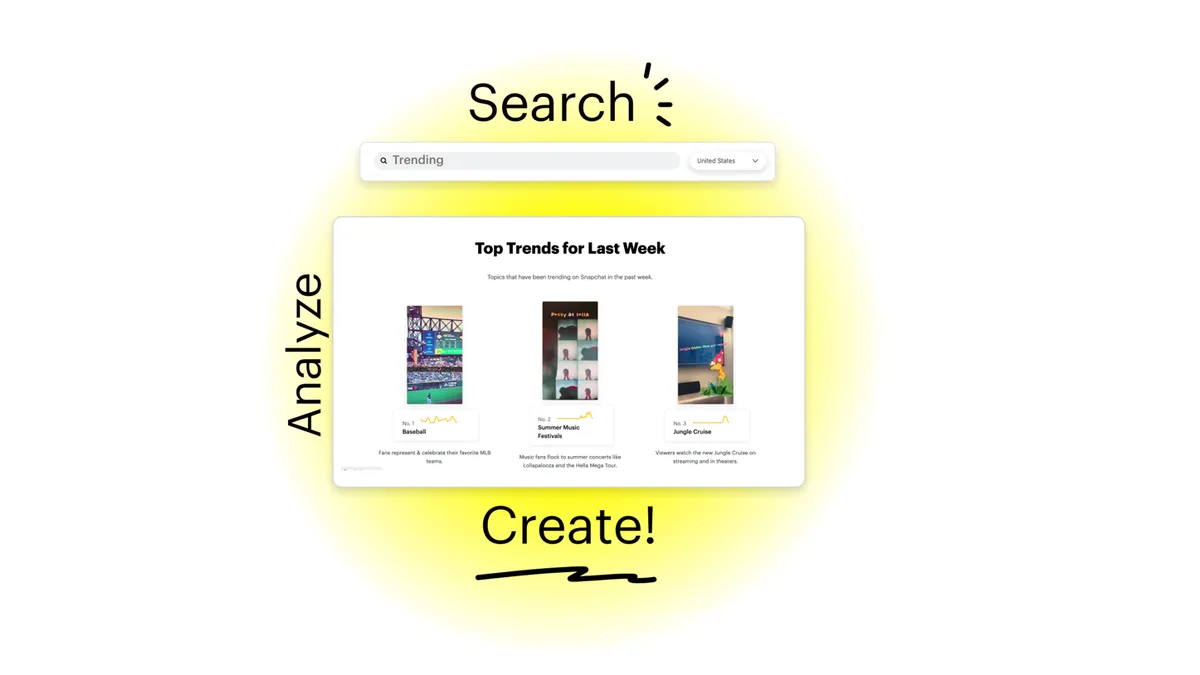Snapchat hosts a vast number of conversations among the 293 million people who use the photo-messaging app each day. The platform in August unveiled Snapchat Trends, helping marketers seeking insights into topics that spur the most visible discussions among younger consumers.
The website for the social listening tool not only showcases the most popular trends from the past week, but provides insights into how often keywords are used in photo captions. Snapchat Trends doesn't monitor private messages, and instead highlights wording from public Stories and My Stories viewed by a big group.
"It's a platform-specific market research tool that brands can use to inform their marketing strategy," said Jasmine Enberg, an eMarketer senior analyst at Insider Intelligence. "It provides marketers with heaps of new data on Snapchat users and highlights broader trends within the Snapchat community, which brands can use to plan their campaigns and overall strategy both on and off the platform."
The introduction of the trends tool comes as Snapchat shows greater momentum in expanding its reach. The app's daily active users (DAUs) in the second quarter rose 23% from a year earlier — the fastest growth in four years. The continued expansion of its user base and bigger selection of advertising formats helped parent company Snap to more than double its revenue to $982.1 million during the period. The platform saw strength in features such as its TikTok lookalike, dubbed Spotlight, and expanded augmented reality (AR).
Snapchat's social listening tool somewhat resembles Google Trends, which the search giant introduced in 2006 to show the popularity of keyword searches. By providing more transparency into the zeitgeist, Snapchat also is giving marketers another way to monitor social media trends.
"[Snapchat Trends] can help marketers to gauge consumer sentiment around a brand, product or campaign," eMarketer's Enberg said. "It can also help with competitive intelligence, giving brands insight into how their competitors are faring and how their product offering might fit into a market. That can help inform marketing strategy."
An ear to the ground
The market research applications for Snapchat Trends include monitoring which products people are discussing and what kinds of activities they're doing. Marketers can monitor how their brands stand out among rivals in online conversations. The information can help to inform ad creative and copywriting that are contextually relevant to a target audience for different categories of products and services.
"Recently, we saw a 100% increase in mentions of the phrase 'third-wheeling' and after digging deeper, found it was a recurring trend that peaked almost every Friday and Saturday," according to Snap's announcement. "For online dating businesses, this trend has been used as directional insight to help fuel new and relevant creative on Snapchat."
Snap also has observed significant activity related to holidays and celebrations — like National Ice Cream Day or International Women's Day — that provide an opportunity for brands to position their messaging and get people to rally around.
"We tend to see a massive groundswell in conversation around these 'in-between' holidays," per Snap's announcement. "For any brand looking to 'own' a relevant moment, Trends can be a powerful planning tool in finding the right moment with which to align a media strategy."
"It can also help with competitive intelligence, giving brands insight into how their competitors are faring and how their product offering might fit into a market. That can help inform marketing strategy."

Jasmine Enberg
EMarketer senior analyst, Insider Intelligence
Snapchat is particularly popular among younger consumers sought by advertisers. It reaches more than 90% of people ages 13 to 24 in the U.S., U.K., France, Australia and the Netherlands, Snap's internal data shows. It also reaches more than 75% of people ages 13 to 34 in those regions.
"The oldest members of Gen Z are now entering adulthood, and as the first true digital natives and the most racially and ethnic diverse generation thus far, their characteristics, habits and buying preferences are significantly different from previous generations," Enberg said. "They are digitally savvy and pragmatic. They value individualism and are socially conscious — which are all traits they expect and appreciate from the brands they engage with as well."
Monitoring current trends also is vital to digitally native brands and direct-to-consumer (DTC) sales efforts amid the growth in e-commerce. While people have been shopping online for years, the pandemic led to a significant surge in e-commerce activity as homebound consumers ordered a wider range of goods for delivery.
"We expect digitally native [DTC] e-commerce sales in the U.S. to reach $129.3 billion in 2021, up by 15.9% over 2020," Enberg said, adding that the number excludes travel and event ticketing, as well as sales from food and drink services. "[Snapchat Trends] provides them with market data and trends from their core audience, which can help inform their marketing and e-commerce strategies."




















